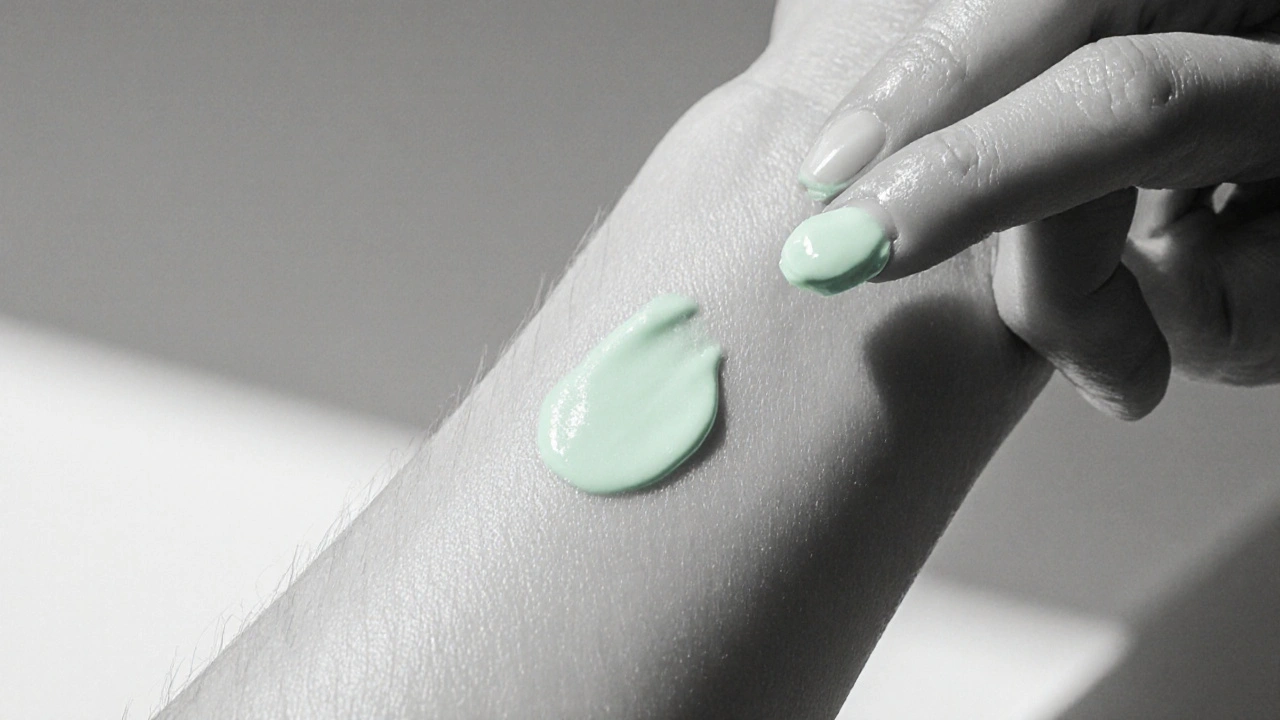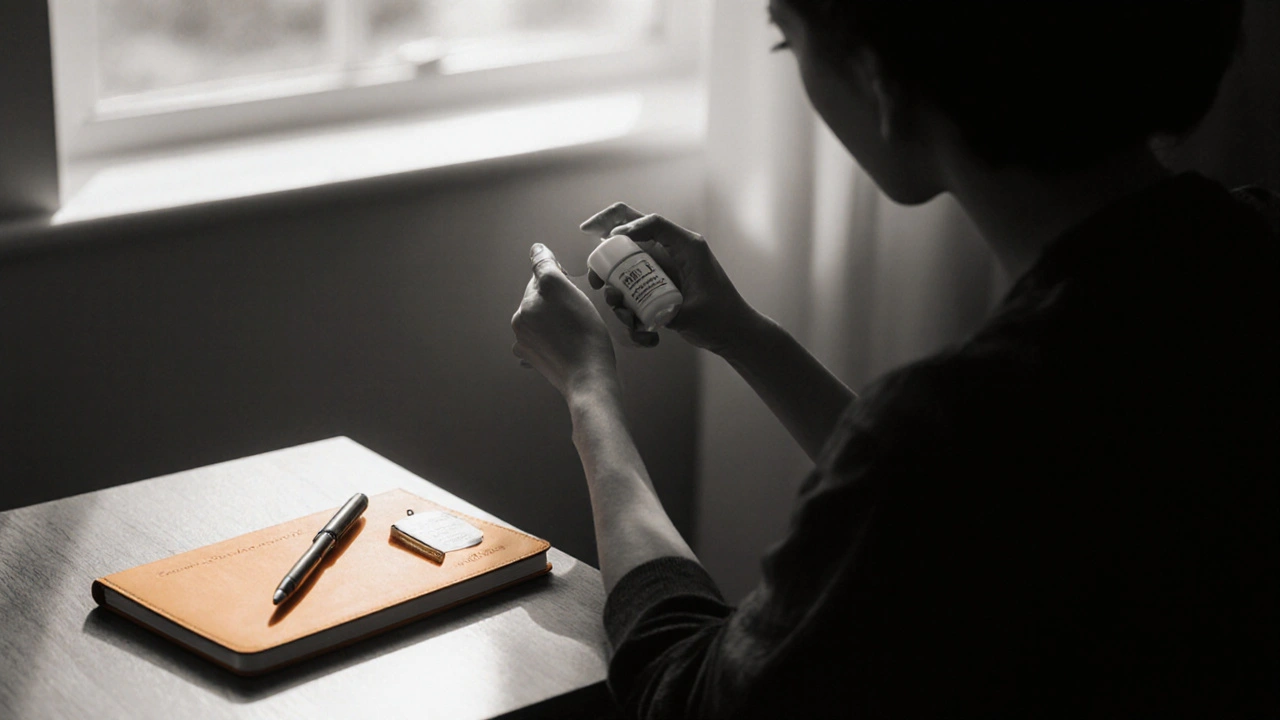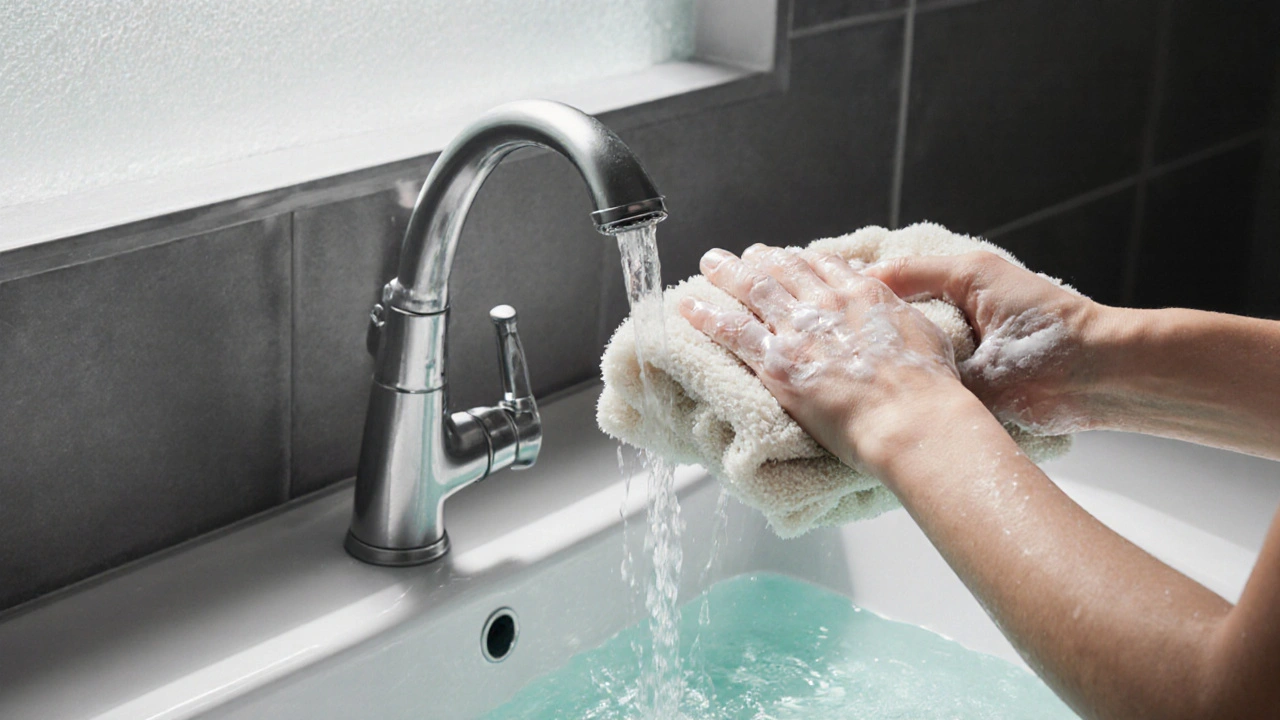Pimecrolimus Cream Application Calculator
Application Guide
Recommended Application
Amount per application:
Wait time before covering:
Moisturizer timing:
Important: Always use fingertip unit (0.5g) for accurate application. Do not exceed recommended amount.
Struggling to get the most out of your eczema treatment? The difference between a flare‑up and calm skin often lies in how you use the medication. Below are proven, easy‑to‑follow tips that will help you apply pimecrolimus cream the right way, reduce irritation, and keep the condition under control.
Key Takeaways
- Always start with clean, gently pat‑dried skin.
- Apply a thin, fingertip‑sized amount to the affected area.
- Wait at least five minutes before covering the skin.
- Use a moisturiser immediately after the cream is absorbed.
- Track side‑effects and contact your doctor if they persist.
Why Proper Application Matters
When used correctly, Pimecrolimus cream is a topical immunomodulator that reduces inflammation without the skin‑thinning risks of steroids. Mis‑application can lead to reduced efficacy, unnecessary irritation, or even systemic absorption. Understanding the science behind the product helps you avoid those pitfalls.
Preparation: Setting the Stage
Before you reach for the tube, gather these essentials:
- Mild cleanser - Choose a fragrance‑free, pH‑balanced soap that won’t strip the skin of natural oils.
- Soft towel - Pat the skin dry; never rub.
- Moisturiser - Look for ceramide‑rich, hypoallergenic formulas to restore the barrier after the cream has absorbed.
- Prescription label - Keep it handy to confirm dosage and frequency.
Having everything within arm’s reach cuts down on distractions and ensures you follow each step without rushing.

Step‑by‑Step Application Technique
- Wash the affected area with the mild cleanser, then rinse with lukewarm water.
- Gently pat the skin dry. It should feel slightly damp, not wet.
- Dispense a fingertip‑sized amount (about 0.5g) of Pimecrolimus cream onto the tip of your index finger.
- Spread the cream in a thin, even layer over the lesion. Use light strokes; avoid massaging aggressively.
- Wait 5-10minutes to allow the product to penetrate before putting on clothes or bandages.
- Apply your moisturiser once the cream feels absorbed. This locks in hydration and supports the skin barrier.
Repeating the routine twice daily (or as prescribed) yields the best results.
Post‑Application Care
After the cream has settled, follow these habits to maximise benefits:
- Keep the treated area out of direct sunlight for at least an hour; UV exposure can trigger flare‑ups.
- Avoid hot showers or baths for a few hours, as heat can increase absorption and irritation.
- Log any itching, burning, or redness in a skin diary; patterns help your doctor adjust treatment.
Common Mistakes to Avoid
Even seasoned patients slip up. Here’s what to watch out for:
- Using too much. More isn’t better; excess can rise into the bloodstream.
- Applying over dirty skin. Residual soap or sweat creates a barrier that blocks the cream.
- Covering immediately. Occlusive dressings trap heat and increase the risk of side‑effects.
- Skipping moisturiser. Without barrier repair, the skin remains vulnerable.

When to Seek Professional Help
If you notice any of the following, contact your dermatologist promptly:
- Persistent burning or stinging lasting more than 15minutes.
- Unexplained swelling, redness spreading beyond the target area.
- Signs of infection-pus, crusting, or foul odor.
- Unusual skin discoloration or thinning.
Remember, Doctor a licensed medical professional who can adjust dosage or suggest alternative therapies is your ally in managing chronic skin conditions.
Comparison: Pimecrolimus vs. Topical Corticosteroids
| Attribute | Pimecrolimus Cream | Topical Corticosteroid |
|---|---|---|
| Mechanism | Immune modulation (inhibits T‑cell activation) | Anti‑inflammatory (suppresses cytokine production) |
| Skin‑thinning risk | Very low | Higher, especially with prolonged use |
| Typical use | Atopic dermatitis, mild‑to‑moderate eczema | Various inflammatory skin conditions, acute flare‑ups |
| Prescription requirement | Yes (prescription‑only in most countries) | Often requires prescription for medium‑high potency |
| Age restrictions | Approved for children ≥2years (some regions 12months) | Depends on potency; low‑strength steroids can be used in infants |
Choosing the right product hinges on your doctor’s assessment, the severity of the rash, and your skin’s tolerance. For long‑term maintenance, many clinicians favour pimecrolimus because it spares the skin from steroid‑related side effects.
Frequently Asked Questions
How often should I apply pimecrolimus cream?
The usual regimen is twice daily-once in the morning and once before bedtime-unless your doctor advises otherwise.
Can I use pimecrolimus on my face?
Yes, it’s commonly prescribed for facial eczema because it doesn’t thin the skin like steroids do.
What should I do if I miss a dose?
Apply it as soon as you remember, but skip it if it’s almost time for the next scheduled dose. Do not double‑dose.
Is it safe to use pimecrolimus while pregnant?
Current data are limited; discuss risks and benefits with your obstetrician before continuing.
Can I combine pimecrolimus with other eczema treatments?
Often yes. Moisturisers, bleach baths, or antihistamines can complement therapy, but always check with your dermatologist first.
By following these practical tips, you’ll give pimecrolimus the best chance to calm inflammation, protect your skin barrier, and keep flare‑ups at bay.





Val Vaden
October 15, 2025 AT 12:29Just another reminder, folks :)
lalitha vadlamani
October 21, 2025 AT 07:23While the guidelines are evidently thorough, one must question the underlying assumption that all patients possess the discipline to adhere to such regimented protocols. The text, albeit well‑structured, seems to presume a level of compliance that is rarely encountered in real‑world practice. Moreover, the emphasis on cleanliness overlooks cultural variations in hygiene practices, which may render the advice less universally applicable.
kirk lapan
October 27, 2025 AT 01:16Okay, let me break this down for the sake of everyone who apparently skimmed the article.
First, the author mentions "clean, gently pat‑dried skin" – fine, but they omit the fact that over‑drying can actually disrupt the barrier function, something most dermatologists stress.
Second, the fingertip‑sized amount – why such vague metric? A 0.5g dose is roughly the size of a pea; calling it a fingertip‑sized scoop invites inconsistency.
Third, waiting five minutes before covering – this is sound, but they fail to note that occlusion can be beneficial for certain chronic lesions if used under medical supervision.
Fourth, the moisturiser step – they mention ceramide‑rich formulas, which is a good call, yet they neglect to advise against fragrances altogether, a known irritant.
Fifth, tracking side‑effects – a laudable suggestion, but the article could have provided a simple template for a skin diary.
Sixth, the caution about systemic absorption – technically true, but the risk is negligible when applied as directed.
Seventh, the table comparison – nice visual, but it lacks nuance regarding potency gradations of steroids.
Eighth, the FAQ – correct, but the answer about pregnancy is too vague; patients need concrete guidance.
Ninth, the emphasis on twice‑daily dosing – some clinicians adjust frequency based on severity, an important point missing here.
Tenth, the advice against hot showers – legit, yet many patients find lukewarm showers soothing; a balanced view would be better.
Eleventh, the suggestion to avoid immediate covering – again, occasionally recommended for enhanced drug penetration.
Twelfth, the note on UV exposure – crucial, but should include sunscreen recommendations.
Thirteenth, the mention of “no skin‑thinning risk” – correct, but long‑term safety data still warrants monitoring.
Fourteenth, the omission of cost considerations – a practical barrier for many users.
Fifteenth, the lack of discussion on insurance coverage – another real‑world hurdle.
In summary, the article is a decent primer, yet it glosses over several practical nuances that could make or break patient adherence.
Landmark Apostolic Church
November 1, 2025 AT 20:09There’s something almost meditative about turning a daily treatment into a ritual. When you pause to cleanse, pat dry, and then gently spread the cream, you’re not just applying a medication – you’re signaling to your skin that you care. This mindfulness can reduce stress, which is known to exacerbate eczema. Think of it as a quiet dialogue between you and your body's barrier. By respecting that rhythm, you may find the flare‑ups less frequent, not merely because of the drug, but because of the calm you bring to the process.
Matthew Moss
November 7, 2025 AT 15:03Patriotically speaking, our skin is an often‑overlooked front line. Using proper technique isn’t just personal hygiene; it’s a matter of national health pride. A thin layer, proper waiting time, and follow‑up moisturizer keep the skin strong, just like a well‑trained soldier. Skipping steps is akin to abandoning a post – it compromises the whole defense.
Antonio Estrada
November 13, 2025 AT 09:56I appreciate the thoroughness of the guide and would add that consistency is key. Keeping a simple log-date, time, any sensations-helps both you and your dermatologist spot patterns. Pairing the cream with a fragrance‑free moisturizer can reinforce the barrier, especially after a shower.
Andy Jones
November 19, 2025 AT 04:49Oh, brilliant, another "just follow the steps" article. As if we’re all living in a sterile lab. Sure, write down your feelings, but most of us can’t decipher medical jargon anyway. If you want real advice, maybe ask a dermatologist instead of a blog post.
Kevin Huckaby
November 24, 2025 AT 23:43Wow, what a masterpiece! 🌟 I love how they remind us to keep the skin out of the sun for an hour – like a secret superhero code! 🔥 And the emojis? Absolutely on point. 😂
Brandon McInnis
November 30, 2025 AT 18:36Reading this felt like sitting by a cozy fire while someone narrates a bedtime story about skin care. The step‑by‑step flow is comforting, and the reminder to avoid hot showers adds that extra layer of tenderness we all need.
Allison Marruffo
December 6, 2025 AT 13:29Great perspective! Just remember to stay kind to yourself if you miss a dose – it happens. Consistency over perfection is what truly makes the difference.
Ian Frith
December 12, 2025 AT 08:23From a clinical standpoint, the emphasis on a thin layer cannot be overstated. Excessive amounts increase the risk of systemic exposure, which, while rare, should be avoided. Additionally, the timing before occlusion allows for optimal absorption and reduces the likelihood of heat‑related irritation. Pairing pimecrolimus with a ceramide‑rich moisturizer not only restores barrier function but also prolongs the drug’s efficacy. For patients with facial involvement, the cream’s non‑steroidal nature makes it especially valuable, as steroid‑induced atrophy is a genuine concern. Finally, always document any adverse sensations – burning, itching, or redness – and communicate these promptly to your dermatologist to adjust therapy as needed.